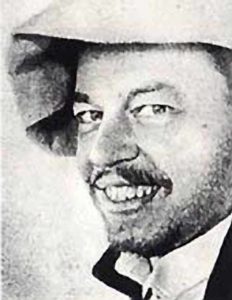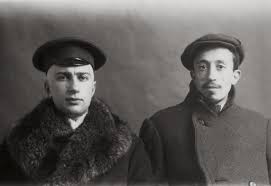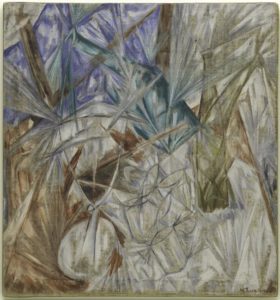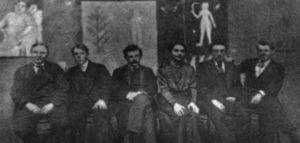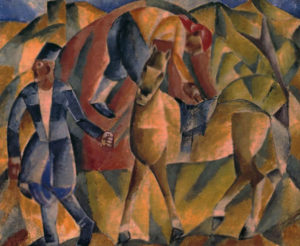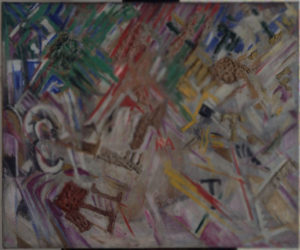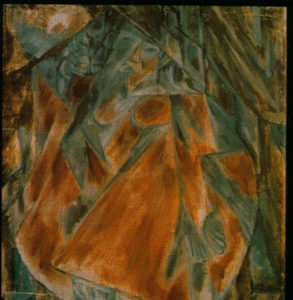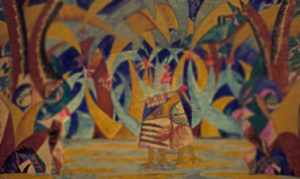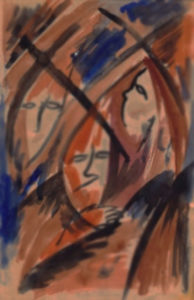He was born on February 8, 1891 in Tver province (Bezhetsk district, Chizhovo village).
1891 - 1917
Mikhaïl Le Dentu
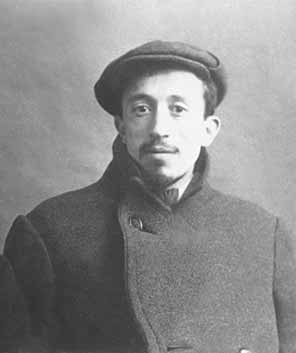
description
A Russian artist, a talented painter and a graphic artist, one of the leading practitioners and theoreticians of avant-garde, in particular, a member of «The Donkey’s Tail group», the creator of the Futurist group named “Bloodless Murder”, which published the eponymous magazine.
He was born into the family of Russified Frenchman Basil Le Dante, a state doctor who was soon killed in the fight against the epidemic of cholera. Having inherited artistic talent from his parents, Michael began to paint at the age of 3-4.
Searching for a technology for “new frescoes” the artist created murals of cabaret, cinema (not preserved, but mentioned by friends and art historians). As a magnificent graphic, he created drawings for “Bloodless Murder» magazine, in particular, he is known for his “Triple Self-Portrait in Military Form” (1915)
Le Dante was the first to discover N. Pirosmanishvili’s art and the first collector of his paintings.
Key Ideas:
– Being a colleague of Mikhail Larionov, Le Dentu sought experimental techniques. Among the few remaining works of a short creative career, there are a number of works that demonstrate how the artist builds light rays as if they break through the crushing faces of the glass. The forms are illustratively archaic, for example, in «The Portrait of Fabbri», they are rough in a primitivist way and very expressive.
– Breaking with the St. Petersburg Academy of Arts and his new Moscow friends, Mikhail presents previously unseen canvases, the stylistics of which is close to the folklore style. His paintings are not as barbaric-bright as the works of Larionov, A. Shevchenko or Goncharova – he mainly appeals to the shades of blue, brown or greenish-gray colors.
– The figures of the characters, especially the heroes of the Georgian cycle, are monumental and decorative. Usually, they are frontal and flat, with a rhythm of lines close to ornamental, as if intended for a wall. In general, the search for a monumental large style determines the entire brief life of Michael Le Dante.
– The young, but already mature artist is attracted to the task of embodying time as a philosophical category on the two-dimensional plane of the canvas, he introduces the “fourth dimension” into his painting, which emphasizes the proximity to the experiences of the futurists. In the picture named “Turning the car” the speed and dynamics of the technical miracle at the beginning of the century found expression in the flying “centripetal” composition, the rhythm of which creates the tactility of the bend at high speed.
Michael Le Dentu actively advocated for persistent self-education, as well as the analytical study of the history of the cultures of different countries. The circle of his own interests was extensive: the East, the West and the art of Africa, the folk crafts of his country, Ukraine and Georgia, the newest experiments and trends among European painters.
1891
1908 - 1909
1910 - 1911
1912
1913
1914
1915
1916
1917
The birth of the artist
Visited the School at the Imperial Academy of Arts
After graduating from the Third Real School of Petersburg, he took lessons from artist Seidenberg, studied at the private studios of Ya. F. Tsionglinsky and M. D. Bernstein. Visited the School at the Imperial Academy of Arts and entered the Academy (did not graduate from there). He joined the group of artists that formed “Union of Youth”.
Exhibited his paintings at two exhibitions of "Youth Union" in St. Petersburg
Exhibited his paintings at two exhibitions of “Youth Union” in St. Petersburg. Participating in the production of drama “Tsar Maximilian and his rebellious son Adolf” (1911), he was passionately carried away by the elements of the national Russian lubok. Enrolled in the Nikolayev Cavalry School, which he soon left as in his mind he remained in art.
He moved to Moscow
Having left the Academy of Arts, he moved to Moscow, where along with M. Larionov and N. Goncharova, S. Romanovich and A. Shevchenko he prepared outrageous exhibition “Donkey’s Tail”. When Le Dentu arrived in Tiflis at the invitation of K. Zdanevich, one of the main events of the artist’s creative life took place: a meeting with the naive pictures of Pirosmani in dukhan “Varangian”. Actively sought and purchased the paintings by Nico, becoming the first professional artist who appreciated the national genius of Georgia. In half a year of stay in the country, he visited Surami, Borjomi, Tskhinvali, fixing sights and samples of folk art, crafts, architectural ornaments.
Finished the series of works of the Georgian cycle started in Tbilisi
Finished the series of works of the Georgian cycle started in Tbilisi (“Man with a Horse”, “The Seller of a Matsoni”, “Buffalo”, “Sazandar”, “Happy Ossetia”, “Georgian Dance”, etc.), some of which were given on exhibition “Target”, organized by M. Larionov. At the same place, Le-Dentu exhibited the purchased paintings of N. Pirosmanishvili (“The Girl with a Mug of Beer”, “The Deer”, “Still Life”, “Portrait of Ilya Zdanevich”).
Participated in the exhibition of paintings
Participated in the exhibition of paintings “No. 4. Futurists, Rayonists, Primitive artists” (Moscow); became the inspirer and one of the founders (together with O. Leshkova, N. Lapshin, V. Ermolaeva) of literary and artistic futuristic group “Bloodless Murder”, which published a unique manuscript eponymous magazine.
The only personal lifetime official exhibition
The only personal lifetime official exhibition of works was held in Petrograd; the informal one took place at the apartment of V. Ermolaeva. He created many drawings for various issues of magazine “Bloodless Murder” (“The Issue of the Fiji Islands”, “Dagestan”, “Assiro-Babylon”, “Albanian”, “In the Rear”, “Evacuation”, etc.). The artist was mobilized. For several months he studied military service at the Vladimir Infantry School, was released in the officer’s rank of ensign.
Was sent to the fronts of the First World War
Was sent to the fronts of the First World War. He reported in a letter to his mother that “the post is very funny: the head of the team of maskers, the duties are close to decorative art”. None of the “war period” – icons for the marching church, scenery of the wandering theater, sketch drawings – has survived.
The death of the artist
He died on August 25, 1917 in Proskurov city (now Khmelnytsky, Ukraine).
Mikhaïl Le Dentu
On Artist
flow
Cubism
friends
Mikhail Larionov
Natalia Goncharova
Alexander Vasilyevich Shevchenko
Sergey Mikhailovich Romanovich
artists
Niko Pirosmani
Vera Mikhailovna Ermolaeva
Alexander Alexandrovich Murashko
Savely Seidenberg
Yang Zionglinsky
Michael Bernstein
Viktor Sergeevich Barth
Vladimir Tatlin
Georges Braque
Pablo Picasso
By Artist
friends
Maurice Fabbru
Vladimir Tatlin
artists
Nikolay Lapshin
Kirill Zdanevich
Maurice Fabbri
Yanko Alexi

